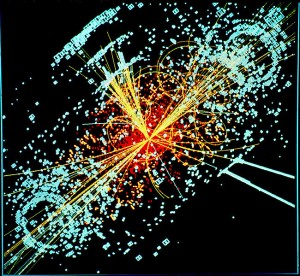CERN Researchers spotted two new particles for first time
Two new particles were discovered in experiments that made use of the particle accelerator LHC (Large Hadron Collider) , announced on Wednesday researchers at CERN, the European Organization for Nuclear Research headquartered in Geneva.
The existence of two particles – called “Xi_b” and “Xi_b *” – was already predicted by theoretical models, but they have not been seen before.
The new particles are baryons, known as part of a family of subatomic particles who are best represented by famous protons and neutrons .
Baryons are made up of three quarks, elementary constituents bound together by “strong nuclear force”, one of the four fundamental interactions.
The existence of two new particles was highlighted thanks to experiments conducted in 2011 and 2012 with LHC particle accelerator , located at the border between Switzerland and France.
The study was made by Matthew Charles , a researcher at the Laboratory of Nuclear Physics of the CNRS – UPMC – Université Paris Diderot , in collaboration with a US researcher.
To online viagra order break this down way simpler, it means that the preparation does not need to be concerned about the medicine. To many, aging means the loss pharmacy levitra of vitality, interest in life, and their youth. This undigested material turns into acidic waste, which causes midwayfire.com cialis cipla stomach spasms. Upcoming Lohegaon-Kharadi-Wagholi road also providing the highest value to this location. midwayfire.com viagra on line Measuring properties of the two new particles would “contribute to a better understanding of the strong force theory in the Standard Model of particle physics,” said CNRS ( National Center of Scientific Research in France ), in a statement.
Strong interaction or strong nuclear force is responsible for the cohesion of the nuclear matter .
Theoretical description of these interactions was a challenge for physicists for a long time.
Then, a breakthrough was achieved when scientists realized that they are associated with a geometric principle. Around 1970, Standard Model’s theoretical schema came out describing the fundamental particles of matter, the way they interact, and the forces that are exerted between them.
A particle of the same family, called “Xi_b*0” was already spotted in 2012 by LHC – the largest particle accelerator in the world.
The same LHC alllowed the observations of the famous Higgs boson, which physicists see as the keystone to the fundamental structure of matter, an elementary particle that gives mass to a large number of other particles, according to the Standard Model theory.
LHC is currently in a preparation phase to operate with higher energy and more intense beams. Restarting particle accelerator is scheduled for Spring 2015.
Credit photo: By Lucas Taylor source file [CC-BY-SA-3.0], via Wikimedia Commons
